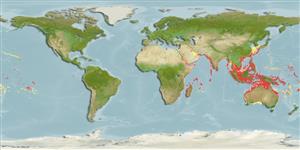Environment: milieu / climate zone / depth range / distribution range
Ecologie
marien; brak water rifbewoner; diepte 1 - 80 m (Ref. 58302). Tropical; 35°N - 35°S, 24°E - 135°W
Indo-Pacific: Red Sea and the east coast of Africa to the Hawaiian Islands and Samoa, north to Japan (Ref. 559), south to the Arafura Sea (Ref. 9819) and northern Australia.
Lengte bij maturiteit / Grootte / Gewicht / Leeftijd
Maturity: Lm ?, range 17 - ? cm
Max length : 30.0 cm TL mannelijk / geslacht onbekend; (Ref. 30573); common length : 26.0 cm TL mannelijk / geslacht onbekend; (Ref. 30573)
Dorsale stekels (totaal) : 9; Dorsale zachte stralen (totaal) : 22 - 25; Anale stekels: 3; Anale zachte stralen: 18 - 21. This species is distinguished by the following characters: adipose eyelid well developed and completely covering eye except for a vertical slit centred on pupil; shoulder girdle (cleithrum) margin smooth, without papillae; terminal dorsal and anal rays finlet-like in adults, about twice length of adjacent rays and a little more separated but joined by interradial membrane; lateral line gently arched anteriorly, with junction of curved and straight parts below vertical from sixth to eighth soft rays of second dorsal fin; scales in curved part of lateral line 39 to 57; straight part with 0 to 10 scales and 36 to 49 scutes; a black spot, slightly smaller than eye, on upper margin of opercle and adjacent area of shoulder; dorsal and caudal fins dusky greenish yellow; anal fin pale yellow (Ref. 9894).
Adults inhabit mangroves and coastal bays in pelagic waters (Ref. 58302). They form schools to about 50 m in inshore waters (Ref. 9894), or singly (Ref. 48635). Are mainly diurnal. They feed mainly on crustaceans and planktonic invertebrates such as copepods, including cephalopods (Ref. 5213, 90102). They swim fast in midwater in pursuit of zooplankton (Ref. 48635).
Paxton, J.R., D.F. Hoese, G.R. Allen and J.E. Hanley, 1989. Pisces. Petromyzontidae to Carangidae. Zoological Catalogue of Australia, Vol. 7. Australian Government Publishing Service, Canberra, 665 p. (Ref. 7300)
Status op de Rode Lijst van het IUCN (Ref. 130435: Version 2024-1)
Gevaar voor de mens
Harmless
Gebruik door de mens
Visserij: van minder commercieel belang; sportvis: ja
Tools
Speciale rapporten
Download XML
Internetbronnen
Estimates based on models
Preferred temperature (Ref.
123201): 23.8 - 29.1, mean 28 °C (based on 2048 cells).
Fylogenetische diversiteitsindex (Ref.
82804): PD
50 = 1.0000 [Uniqueness, from 0.5 = low to 2.0 = high].
Bayesian length-weight: a=0.01349 (0.01204 - 0.01511), b=2.96 (2.93 - 2.99), in cm total length, based on LWR estimates for this species (Ref.
93245).
Trofisch niveau (Ref.
69278): 4.2 ±0.5 se; based on diet studies.
Weerstandsvermogen (Ref.
120179): Hoog, minimale populatieverdubbelingstijd minder dan 15 maanden (K=0.58-1.00; Fec=63,000-161,000 (batch fecundity)).
Fishing Vulnerability (Ref.
59153): Low vulnerability (18 of 100).
Climate Vulnerability (Ref.
125649): Moderate to high vulnerability (47 of 100).
Nutrients (Ref.
124155): Calcium = 79.4 [45.4, 166.2] mg/100g; Iron = 1.04 [0.59, 1.83] mg/100g; Protein = 20 [19, 21] %; Omega3 = 0.193 [0.120, 0.326] g/100g; Selenium = 33.1 [17.7, 62.5] μg/100g; VitaminA = 87.6 [28.1, 279.3] μg/100g; Zinc = 1.17 [0.79, 1.61] mg/100g (wet weight); based on
nutrient studies.
